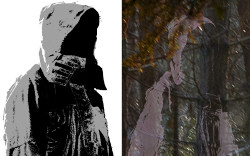Spirits in the Woods (v2)
Spirits in the Woods is a panel of manipulated photos I originally put together eight years ago, when I entered my first annual exhibition organised by Croydon Camera Club.
Not having entered the exhibition for several years, due to various reasons, but with this year being the 125th anniversary of the club, I made the effort to enter the Photo 2015 exhibition with a re-imagining of that panel.
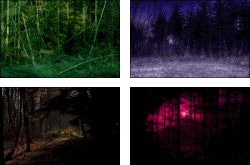
View the Panel
It's the same theme and ideas, reworked into four images, and created from photos
I specifically went out and took for the panel. This was a first for me -
generally I'll go to take photos of whatever I might find, occasionally with
vague notions, but without a clear intent/goal. My previous panels were all put
together independent of the shooting stage.
Having set myself the aim of re-creating the panel, I made notes on what that meant; what I wanted in it. I then decided on a location I hoped would provide the necessary scenes, waited for appropriate weather, then went out solely to get the shots for the panel.
Location
The original version of the panel was made mostly from photos taken in 2006 on holiday to the Isle of Skye and Lochalsh region in Scotland, and primarily a woodland near Glenelg.
It's an incredibly beautiful part of the world and I would have loved to return there, but had to settle for somewhere closer. Every photo that went into v2 was taken at Lyminge Forest in Kent - the sole exception being the crow which is from the same shot used by the original panel.
Lyminge Forest is a popular and relatively well visited area, so getting people intruding into frame was a concern, but the shots I wanted meant going off the main tracks anyway, and it ended up not being an issue. Of course, appropriate footwear and trousers are useful to get through muddy patches and areas overgrown with brambles and nettles.
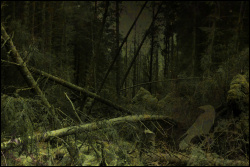
The original version of Destruction.
Intent
I knew I wanted new versions of Haunted Forest and Destruction but remaining similar to the first versions and that I wanted to replace Wraith with something done properly.
Beyond that, I had various ideas, but the key was to create a cohesive panel. I wanted depth, to create pictures that you could get in to and explore, and a panel that guides the imagination in to telling a story.
Shooting
I set about looking for shots with these things in mind, and was fortunate to have a low winter sun providing interesting lighting conditions whilst being bright enough to stick with ISO 400 for most shots, using ±2 bracketing to not lose the detail in high contrast scenes. The flexibility of a 24-120mm f/4 VR meant switching lenses was unnecessary.
I came away with a palette of over 200 exposures, and I use the term palette
intentionally - it was not a case of taking lots of images and hoping to get
lucky, but a deliberate activity of looking for and capturing components and
variations, knowing that I was going to be layering, blending, splicing and
manipulating as necessary to produce what I wanted.
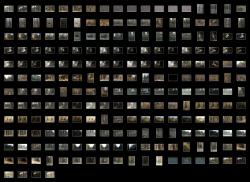
The source images for the panel.
Taking photos of things that are not in themselves a complete image is something I generally do, but as mentioned before, it's usually without the benefit of having specific images in mind.
This focus was particularly useful when I arrived at the area where the images for Wraiths were captured, with the sun streaming through the trees creating an attractive setting. I instinctively started shooting as usual, before reminding myself what I was doing, and switched to framing and composing to suit the image I wanted to create. Had I been working it purely as a natural woodland scene, it would be done differently.
In the past I've avoided projects because too much restriction can reduce enjoyment, but in this case the discipline and mindfulness made it more interesting - I didn't find it overly limiting.
Processing
All four images in the panel were produced differently - I don't have a single set workflow for how I manipulate images; it varies depending on what I'm after, though there are common bits.
The starting point is the same - I backup files to separate hard drives before any application touches them, then use exiv2 to give them useful filenames, move them to a location-based directory structure, and import into Lightroom applying neutral camera profile, daylight white balance, and lens correction.
After that, it depends what I'll be doing with the image - bracketed shots get exported as is to be combined in Luminance HDR, before any further work.
Blood Moon was created from bracketed exposures, as was the primary image for Haunted Forest, though the latter also makes extensive use of layers.
My graphics editor of choice, for layering and other functionality that either is not possible or is more effort in Lightroom, is Paint Shop Pro X (and specifically that, not the newer versions!)
When an image is going to be layered, I usually make initial adjustments in Lightroom to exposure, contrast, etc (depending on how it's going to be used), and if later fine-tuning is necessary, I adjust the layer opacity, and/or use a suitable adjustment layer.
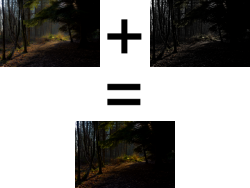
Layering variants of an image can provide a wide variety of effects.
For Wraiths I used Lightroom's Create Virtual Copy functionality and developed
two versions of the same image - one an under-exposed saturated colour layer with
clarity taken right down, the other desaturated to almost monochrome with high
contrast provided by taking clarity in the other direction - then put the latter
on top with Luminance blend mode to give the succesful effect.
Why do it that way? It's a question of experience and experimentation - I've been working with layers long enough to have a reasonable idea of how things go together, and that has been achieved by regularly trying all the different blend modes, even when I know what I'm after, to help get a feel for how different types of images and modes will combine.
This of course applies to more than just layers - whatever tools you use, don't stick to presets or traditional/obvious settings, but play with all the options, take them to extremes, and see what they do - most of the time they wont work (though sometimes you'll get lucky), but more importantly you'll be learning what they do and getting an idea of when you can use them.
Put another way: some parts of photography are about being lucky, but you can cultivate luck by experimenting with and understanding your tools - at both the shooting and processing stages.
The wraiths themselves were created by using PSP's warp brush on a
silhouetted photo of a hooded figure, allowing the pixels to be dragged,
twisted, and jiggled into different ghostly shapes.
(Photoshop's equivalent to this tool is the "Liquify filter", whilst GIMP has "iwarp".)
Each wraith was placed within its own layer group - allowing for different blend modes, adjustment layers, and masking as appropriate for its environment.
As I was creating all the images, I frequently put together the
WIP shots and looked at them as a panel,
helping to ensure they fit together visually whilst they were still being developed.
Also important was taking time to step away from the images. Sometimes having them on as a slideshow, other times deliberately not looking at them at all - making sure that when I came back I was still happy, and spotted issues that may be obvious to fresher eyes - it's surprising what you can miss when you've been looking at something for a long time.
The Result
In the end, I'm happy with the result, and consider my goal to be accomplished.
There are both obvious and subtle links to the original panel, but it is also clearly a successor and not merely the same thing again.
For me, this has always been about more than just putting together the final images, and I hope sharing some of the details of what was involved has been useful, interesting, and perhaps even provided ideas for others.
Something I've heard often from camera club photographers is that you only take pictures for yourself, and whilst that isn't specifically false, if I'm the only person to enjoy an image then I have not been wholly succesful.
As hobbyists, we don't need to please other people (in the way that people making a living from it must), but my measure of an image's success nevertheless extends to how well it entertains, inspires, and communicates.
If I can fire someone's imagination or generate enthusiasm - whether they see it as I do or with their own interpretation - knowing I've done this is my victory, and makes my efforts worthwhile.

